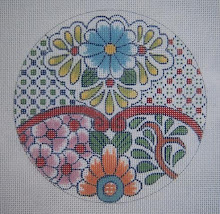 It's time to add a few more major pattern elements, and my idea from the beginning was to add one nice scallop shell.
It's time to add a few more major pattern elements, and my idea from the beginning was to add one nice scallop shell. The first step was to make a tracing of what I'd already done - the coral and the sea urchn, along with the line of the sand. Then, I sketched with a pencil, to make sure of the size, shape, and placement I wanted.
Then I traced, stitch by stitch, onto a piece of scrap canvas, the outline of the shell so it would be symmetric. The arrows are pointing to places I didn't like, so made adjustments when I put it onto the waste canvas.
 This is a project that is building a little bit at a time from a pre-conceived "picture" in my head - and I have to be careful not to treat each element as a separate thing, as the "whole" has to work together or become an "eye shattering mess."
This is a project that is building a little bit at a time from a pre-conceived "picture" in my head - and I have to be careful not to treat each element as a separate thing, as the "whole" has to work together or become an "eye shattering mess."Next was to dot the shape onto the waste canvas. I used the Sharpie extra fine permanent marker in blue, as I didn't want black to show through and distract me.
About the waste canvas: This is a penelope canvas that is a double stranded even weave with no discernable warp or weft, although it does have them. With the penelope, as it was used in the late 19th century, (called "Berlin work.") and even into the 1980's, was mainly for stitching backgrounds around preworked centers and in continental stitch. The penelope holds this stitch well, as it has the double strands, but it's still unattractive with the resulting horizontal ridges. Also, the little intersections could be split, and petit point was made for finer detail in the design.
I first saw waste canvas in about 1985, as it was a thing for counted cross stitchers. They were using it to stitch little motifs from charts onto T-shirts, Sweat shirts, etc. - even little blankets and such. It's very very thin and flimsy, as it's sized only with water soluble glue, and can be easily pulled out when the work is finished, leaving the stitches in place.

Many years ago, I helped a customer put a set of Mah Jong tiles (three to each corner) onto a velveteen card table cover. On 18 mesh canvas, even, they would have been too thick to finish by sewing them on - so we pinned the canvas onto the velveteen - she stitched it, and then with pliers and some very bad words, we pulled the canvas threads out, one by one, and Voila'!!! The effect was stunning!
Remembering this is what led me to decide to raise this shell above the surface of the needlepoint background for more effect. I hope it works! If it doesn't, you won't hear about it again. We shall see.

The last photo shows the waste basted into place and ready to stitch. At this point, I switched to a chenille needle (#22), as it requires the sharp point to go through the fabric of the needlepoint background.

2 comments:
I haven't used waste canvas since the 70s. This should be a wonderful addition to this piece. I can't wait to see how it works out!
Hi Judy,
Cool!
Looking forward to seeing how it looks.
Cynthia
Windy Meadow
Post a Comment